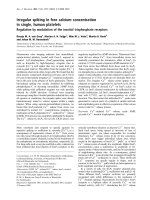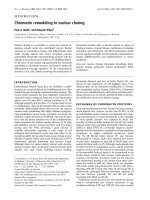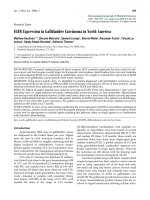Báo cáo y học: "Prokinetic agents in critical care" potx
Bạn đang xem bản rút gọn của tài liệu. Xem và tải ngay bản đầy đủ của tài liệu tại đây (37.71 KB, 3 trang )
206
EN = enteral nutrition; RGV = residual gastric volume.
Critical Care June 2003 Vol 7 No 3 Doherty and Winter
Early enteral feeding is now recognized as one of the
fundamentals of critical care practice [1–4]. Enteral nutrition
(EN) increases gut blood flow, thereby protecting the gastric
mucosa [5,6]. Early feeding results in fewer septic
complications, decreased catabolic response to injury,
decreased stress ulceration in the ventilated patient, improved
gut immune function and improved wound healing [3,4,7,8].
Successful enteral feeding relies on intact gastrointestinal
motility, which is frequently impaired in the critically ill.
Prokinetic agents have a valuable role to play in this situation.
A recent review by Booth and coworkers [9] with an
accompanying editorial [10] in Critical Care Medicine
systematically reviewed the evidence for the use of
gastrointestinal promotility drugs in critical care. The context
of the review was that promotility agents may improve
tolerance to EN, and reduce gastroesophageal reflux and
pulmonary aspiration; they therefore have the potential to
improve outcomes of critically ill patients. The authors appear
to have conducted a comprehensive search of the available
literature over the preceding two decades. The studies were
then methodologically assessed for their quality using a
previously described scoring system, with attempts made to
contact the primary investigators for further information where
this was thought necessary.
The review scrutinized 18 studies involving a total of 908
individuals. A significant proportion of the review examined
the role of prokinetics in aiding tube placement, whereas the
remainder looked at the effects of cisapride, erythromycin
and metoclopramide on gut transit/feeding tolerance. (For a
summary of the actions of those agents, see Table 1.)
Cisapride is currently unavailable in many countries because
of cardiac toxicity [11].
A breakdown of the reviewed studies is shown in Table 2. If
we exclude the studies on tube placement, those with end-
points that involved patient outcomes and those
gastrointestinal transit studies that involved cisapride alone,
then we are left with only six studies (highlighted in Table 2
with asterisks), involving 80 patients, that examined agents
that are available as prokinetics in contemporary practice.
The review justified the inclusion of cisapride because there
are currently new generation agents undergoing trials;
however, it failed to mention that the studies on the new
motilin receptor agonists (macrolide derivatives), such as
ABT-229, have yielded disappointing results [12,13]. The
authors suggested that we should be more cautious with our
use of erythromycin, given the increasing incidence of
antibiotic resistance, and suggested 20 mg metoclopramide
as first-line treatment. This dose appears to have little
scientific basis because only one of the tube placement
studies [14] used it; the review stated that a dose of 20 mg
was used in the gastrointestinal transit study conducted by
Jooste and coworkers [15], but it actually employed a 10 mg
dose. The value of the review is that it highlights the lack of
any large methodolical studies on which to base treatment
recommendations.
Commentary
Prokinetic agents in critical care
Warren L Doherty
1
and Bob Winter
2
1
Fellow, Adult Intensive Care Unit, University Hospital, Queen’s Medical Centre, Nottingham, UK
2
Consultant, Adult Intensive Care Unit, University Hospital, Queen’s Medical Centre, Nottingham, UK
Correspondence: Warren L Doherty,
Published online: 10 January 2003 Critical Care 2003, 7:206-208 (DOI 10.1186/cc1849)
This article is online at />© 2003 BioMed Central Ltd (Print ISSN 1364-8535; Online ISSN 1466-609X)
Abstract
Prokinetic agents are commonly used in intensive care, mainly to aid in early enteral feeding. The
present commentary reviews some of the recently published papers and highlights the lack of a sizable
evidence base, as well as the possible importance of euglycaemia in this important clinical area.
Keywords enteral feeding, erythromycin, hyperglycaemia, intensive care, metolopramide, prokinetic agent
207
Available online />In view of recent critical care trials, it is disappointing that
neither the review nor the editorial mentioned the effect of
hyperglycaemia on gastric function. It is now recognized that
increasing blood glucose in both diabetic patients and
normal individuals has a reversible effect on gastrointestinal
motor function [16,17]. Also of note is that the gastrokinetic
effects of erythromycin were attenuated in healthy individuals
when their blood glucose concentrations were increased
from approximately 4 to 15 mmol/l [18].
Another study [19], published in June 2002 in Critical Care
Medicine (too late for inclusion in the review by Booth and
coworkers [9]), examined the effects of erythromycin in
ventilated patients. It adds considerably to the body of
evidence by studying 40 patients randomly assigned to either
placebo or erythromycin 250 mg four times daily in 50 ml 5%
dextrose. Enteral feeding was commenced at 500 ml/day on
the first day, and was increased in 500-ml steps to a
maximum of 2000 ml/day. Residual gastric volume (RGV)
was measured at 6-hour intervals and feed was discontinued
if RGV exceeded 250 ml or the patient vomited. The
treatment group exhibited a significant decrease in RGV for
the first 3 days of feeding and a significant decrease in the
number of patients who were unable to tolerate EN (35%
versus 70%).
The ideal dosing of erythromycin still requires clarification;
the above regimen produced satisfactory outcomes, but
similar results might have been achieved with twice daily
dosing [20]. Erythromycin involves two different pathways
[21], and its effects are known to vary with dosing. A low
dose (40 mg) induces a premature activity front at the antral
level, migrating caudally to the small intestine, and is possibly
mediated by activation of an intrinsic cholinergic pathway.
Higher doses (200–350 mg) induce a prolonged period of
strong antral activity that is not followed by phase 1 and does
not migrate caudally, and is possibly mediated via a pathway
that involves activation of a muscular receptor [22]. The
recent cloning of the motilin receptor may help to clarify the
correct dose from a molecular level [23].
Metoclopramide may well be more efficacious at a dose of
20 mg, but currently there is no evidence to support this in
the absence of an adequately powered and randomized
study. On current evidence, the best dose is probably 10 mg
intravenously three times daily.
Table 1
Summary of features and actions of cisapride, erythromycin and metoclopramide
Drug Receptor Class Action
Metoclopramide Dopamine Motility Sensitizes gut to acetylcholine; increases lower oesophageal sphincter tone
antagonist stimulant
Erythromycin Motilin receptors Macrolide Increased antral activity, which may migrate caudally (depending on dose)
on enteric nerves and antibiotic ± activation of an intrinsic cholinergic pathway
smooth muscle
Cisapride Activates 5-HT
4
Motility Initiates peristaltic reflex by simultaneously activating ascending excitatory and
receptors on intrinsic stimulant descending inhibitory neural pathways
sensory neurones
5-HT, 5-hydroxytryptamine.
Table 2
Summary of studies of gastrointestinal promotility drugs
Number Population
Study design of studies (n)
Tube placement studies (examining the role of prokinetics in aiding transpyloric intubation) 6 351
Patient outcome studies (examining pneumonia and mortality or gastric and pulmonary colonization) 2 330
Studies that examined the effects of the prokinetic agents on gastrointestinal transit and feeding intolerance
Cisapride versus placebo 4 147
Erythromycin versus placebo* 230
Metoclopramide versus placebo* 226
Metoclopramide versus cisapride* 114
Metoclopramide versus erythromycin and cisapride* 1 10
*Studies of agents that are available as prokinetics in contemporary practice.
208
Critical Care June 2003 Vol 7 No 3 Doherty and Winter
This important everyday area of practise noticeably lacks an
evidence base. Perhaps the current move in many units to
more aggressive blood sugar control, which requires a more
constant source of glucose, will provide the impetus for the
much needed further work in patients who are euglycaemic.
Competing interests
None declared.
References
1. Miskovitz P: Gastric prokinetic motility therapy to facilitate
early enteral nutrition in the intensive care unit. Crit Care Med
2002, 30:1386-1387.
2. Marik PE, Zaloga GP: Early enteral nutrition in acutely ill
patients: A systematic review. Crit Care Med 2001, 29:2264-
2270.
3. Zaloga GP: Early enteral nutritional support improves
outcome: hypothesis or fact? Crit Care Med 1999, 27:259-261.
4. Heyland DK, Cook DJ, Guyatt GH: Enteral nutrition in the criti-
cally ill patient: a critical review of the evidence. Intensive Care
Med 1993, 19:435-442.
5. Hadfield RJ, Sinclair DJ, Houldsworth PE, Evans TW: Effects of
enteral and parenteral nutrition on gut mucosal permeability
in the critically ill. Am J Respir Crit Care Med 1995, 152:1545-
1548.
6. Saito H, Trocki O, Alexander JW, Kopcha R, Heyd T, Joffe SN:
The effect of route of nutrient administration on the nutritional
state, catabolic hormone secretion, and gut mucosal integrity
after burn injury. JPEN J Parenter Enteral Nutr 1987, 11:1-7.
7. Kudsk KA, Minard G, Wojtysiak SL, Croce M, Fabian T, Brown
RO: Visceral protein response to enteral versus parenteral
nutrition and sepsis in patients with trauma. Surgery 1994,
116:516-523.
8. Moore FA, Feliciano DV, Andrassy RJ, McArdle AH, Booth FV,
Morgenstein-Wagner TB, Kellum JM Jr, Welling RE, Moore EE:
Early enteral feeding, compared with parenteral, reduces
postoperative septic complications: the results of a meta-
analysis. Ann Surg 1992, 216:172-183.
9. Booth CM, Heyland DK, Paterson WG: Gastrointestinal pro-
motility drugs in the critical care setting: a systematic review
of the evidence. Crit Care Med 2002, 30:1429-1435.
10. Tisherman SA, Marik PE, Ochoa J: Promoting enteral feeding
101. Crit Care Med 2002, 30:1653-1654.
11. Wysowski DK, Bacsanyi J: Cisapride and fatal arrhythmia. N
Engl J Med 1996, 335:290-291.
12. Tack J. Peeters T: What comes after macrolides and other
motilin stimulants? Gut 2001, 49:317-318.
13. Talley NJ, Verlinden M, Geenen DJ, Hogan RB, Riff D, McCallum
RW, Mack RJ: Effects of a motilin receptor agonist (ABT-229)
on upper gastrointestinal symptoms in type 1 diabetes melli-
tus: a randomised, double blind, placebo controlled trial. Gut
2001, 49:395-401.
14. Whatley K, Turner WW Jr, Dey M, Leonard J, Guthrie M: When
does metoclopramide facilitate transpyloric intubation? JPEN
J Parenter Enteral Nutr 1984, 8:679–681.
15. Jooste CA, Mustoe J, Collee G: Metoclopramide improves
gastric motility in critically ill patients. Intensive Care Med
1999, 25:464-468.
16. Jones KL, Kong MF, Berry MK, Rayner CK, Adamson U, Horowitz
M: The effect of erythromycin on gastric emptying is modified
by physiological changes in the blood glucose concentration.
Am J Gastroenterol 1999, 94:2074-2079.
17. Kong MF. Horowitz M: Gastric emptying in diabetes mellitus:
relationship to blood-glucose control. Clin Geriatr Med 1999,
15:321-338.
18. Jones KL, Berry M, Kong MF, Kwiatek MA, Samsom M, Horowitz
M: Hyperglycemia attenuates the gastrokinetic effect of ery-
thromycin and affects the perception of postprandial hunger
in normal subjects. Diabetes Care 1999, 22:339-344.
19. Reignier J, Bensaid S, Perrin-Gachadoat D, Burdin M, Boiteau R,
Tenaillon A: Erythromycin and early enteral nutrition in
mechanically ventilated patients. Crit Care Med 2002, 30:
1237-1241.
20. Chapman MJ, Fraser RJ, Kluger MT, Buist MD, De Nichilo DJ: Ery-
thromycin improves gastric emptying in critically ill patients
intolerant of nasogastric feeding. Crit Care Med 2000, 28:
2334-2337.
21. Coulie B, Tack J, Peeters T, Janssens J: Involvement of two dif-
ferent pathways in the motor effects of erythromycin on the
gastric antrum in humans. Gut 1998, 43:395-400.
22. Tack J, Janssens J, Vantrappen G, Peeters T, Annese V,
Depoortere I, Muls E, Bouillon R: Effect of erythromycin on
gastric motility in controls and in diabetic gastroparesis. Gas-
troenterology 1992, 103:72-79.
23. Feighner SD, Tan CP, McKee KK, Palyha OC, Hreniuk DL, Pong
SS, Austin CP, Figueroa D, MacNeil D, Cascieri MA, Nargund R,
Bakshi R, Abramovitz M, Stocco R, Kargman S, O’Neill G, Van
Der Ploeg LH, Evans J, Patchett AA, Smith RG, Howard AD:
Receptor for motilin identified in the human gastrointestinal
system. Science 1999, 284:2184-2188.









